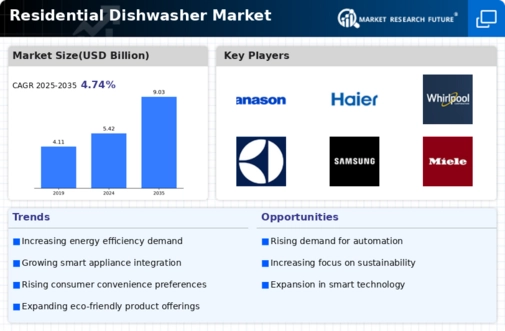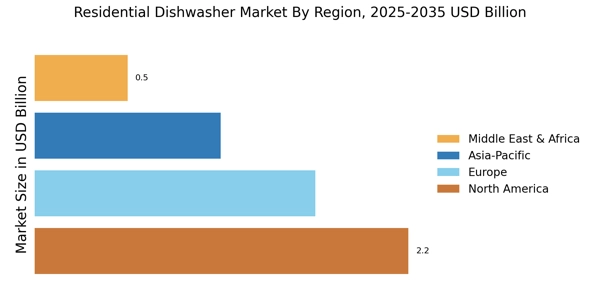Urbanization and Space Constraints
Urbanization is significantly impacting the Residential Dishwasher Market, particularly in densely populated areas where space is at a premium. As more individuals and families move into urban settings, the demand for compact and multifunctional dishwashers is on the rise. These appliances are designed to fit into smaller kitchens while still providing the efficiency and performance expected from larger models. The trend towards urban living is likely to continue, suggesting that manufacturers who innovate in compact designs may find substantial opportunities within the Residential Dishwasher Market, catering to the needs of urban consumers.
Growing Awareness of Sustainability
Sustainability is emerging as a critical driver within the Residential Dishwasher Market. Consumers are becoming more environmentally conscious, leading to a heightened demand for energy-efficient appliances. Dishwashers that meet Energy Star ratings are increasingly favored, as they consume less water and energy compared to traditional washing methods. Recent data indicates that energy-efficient models have seen a sales increase of around 10% in the last year. This trend suggests that manufacturers who prioritize sustainable practices and eco-friendly designs may gain a competitive edge in the Residential Dishwasher Market, appealing to the environmentally aware consumer.
Increased Focus on Health and Hygiene
The heightened focus on health and hygiene is driving growth in the Residential Dishwasher Market. With consumers becoming more aware of the importance of cleanliness, especially in food preparation areas, the demand for dishwashers that ensure thorough sanitation is increasing. Many modern dishwashers now offer sanitizing cycles that eliminate bacteria and viruses, appealing to health-conscious consumers. This trend is likely to continue, as households prioritize appliances that contribute to a cleaner and safer living environment. Consequently, manufacturers that emphasize hygiene features in their products may see enhanced market performance within the Residential Dishwasher Market.
Rising Consumer Demand for Convenience
The Residential Dishwasher Market is experiencing a notable increase in consumer demand for convenience-driven appliances. As lifestyles become busier, households are increasingly seeking solutions that save time and effort in daily chores. This trend is reflected in the growing sales of dishwashers, with a reported increase of approximately 5% in unit sales over the past year. Consumers are prioritizing appliances that not only clean effectively but also offer features such as quick wash cycles and smart connectivity. This shift towards convenience is likely to drive innovation within the Residential Dishwasher Market, as manufacturers strive to meet evolving consumer expectations.
Technological Advancements in Dishwashing Solutions
Technological advancements are playing a pivotal role in shaping the Residential Dishwasher Market. The integration of smart technology, such as Wi-Fi connectivity and app-based controls, is becoming increasingly prevalent. These innovations allow users to monitor and control their dishwashers remotely, enhancing user experience and efficiency. Furthermore, the introduction of advanced cleaning technologies, such as ultrasonic cleaning and improved spray arm designs, is expected to boost performance and energy efficiency. As these technologies continue to evolve, they may significantly influence consumer purchasing decisions, thereby propelling growth in the Residential Dishwasher Market.


















Leave a Comment